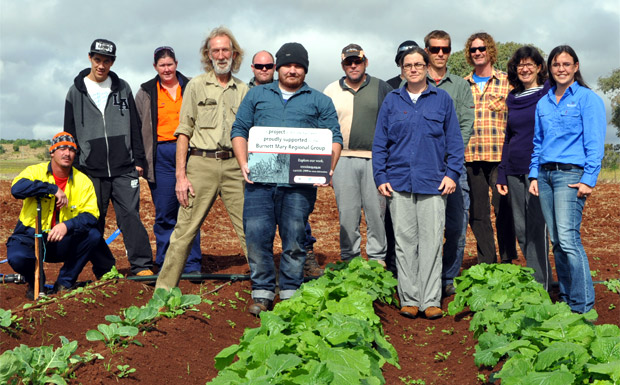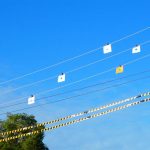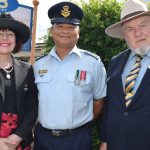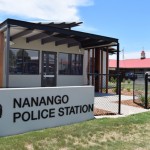
October 28, 2014
Growing The Burnett plans to sell its vision of self-sustainability to the general public, offering investors the opportunity to be part of a community-owned farm.
The announcement was made at the group’s Annual General Meeting held in the Taabinga Room at Kingaroy’s DAFF offices on Monday night.
GTB founder Brian Jarvis said that after the group lost its Memerambi farm in August, it had also lost opportunities to undertake activities such as training and education, along with the ability to produce fresh vegetables for the Thursday farmers markets GTB had established in Kingaroy.
Rather than rely on government funding, he believed the best path forward now was to raise money from the community and use the funds to buy a permanent home for the organisation that would be community-owned.
Final details of the proposal would be nutted out over coming weeks, and a first draft of the scheme was expected to be made available at a fund-raising dinner which will be held in late November.
Mr Jarvis said the funding model members of the group have been considering wasn’t new, but had been successfully used by similar groups in Australia and other parts of the world.
He also said the group has been looking for a new farming property in the region that met its requirements for sustainable farming since early September.
The chief requirements were good soil, access to water and a good aspect.
Several potential sites have already been inspected and others would be inspected in the weeks ahead.
However, he felt the group would be in a stronger position to secure an ideal property for its purposes if it had access to funds before it established a new base.
Mr Jarvis told the 30 people who attended the AGM that while the loss of the group’s first farm in August had been a blow, it had also taught them several valuable lessons he was sure would prove to be positives in the future.
He said the group’s fundamental goals – to undertake and demonstrate sustainable, resilient and community-based farming practices – remained sound.
Anthony Slade was elected President for 2014-15, and Ross Anderson was re-elected Vice-President.
Carmel Summers, from BIEDO, was elected Treasurer; Rosemary Pratt as Secretary; and Alison Shields as Resource Co-Ordinator.
Mr Jarvis’ speech is reprinted below:
2013-14 Founder’s ReportI’d like to begin my report by outlining my own definitions of the core things we are trying to achieve. Here’s what they are:
Our Current SituationThe loss of Memerambi Farm has caused us to lose our centre for action. We have lost our ability to educate and inform the public; our access to revenue generation opportunities; public awareness of what we do; a meeting venue and a social centre for members and the general public; and productivity. We are currently searching for a new farm, and also restructuring how we progress. Creating A Positive FutureWe believe it is possible to create a positive future, but it requires the input and collaboration of the community. There are many ways to improve the future of our region. One is to embrace the resources industry, whose history is one of confrontation as our arable land is often sacrificed and our water quality threatened for short-term, unsustainable gains that require billions of dollars in infrastructure development. Having said that, the resources industry has a role to play in our economically driven society. Another way is to look at those assets that exist within our region and what we can do to improve them; resources that will require far less investment to develop. There are so many things we can do. But, ultimately, success is dependent upon community involvement and our community’s recognition of the power of small actions, and their belief in the potential of the Burnett region. It is also important to recognise the natural environmental significance of our region, because what falls from the heavens here is significant for the well-being of much of South East Queensland. As one example, the water that flows downstream from here plays a major role in the irrigation supply for Bundaberg. So it is important that we help preserve and enhance our great natural resources, because the benefits will far outweigh the effort. Another of our great assets is our arable, fertile land. Although we often lack water, there are many small pockets of land that – when used correctly and with modern watering techniques – can be incredibly productive and sustainable in food production. Our greatest resources, however, are the people that populate our region, their diversity, their wealth of knowledge, their experience and – as was proven in recent natural disasters – their incredible resilience. If we connect all these incredible resources together, then we can develop a framework for community investment that will lift our region’s socio-economic status, be sustainable and enable us to plan not just for our own future, but also for the generations that follow. The Blight Of Rural AustraliaOver the years rural Australia has become more and more vulnerable as our dependence on centralised systems has grown. Whether it be the control of market prices by a few large corporations; or the challenges of limited irrigation water battling with demands from ever-expanding cities and towns; or the resource industry juggernaut; or the needs of the natural environment; there is also the increasing cost of regulations, rising input costs and competition from less favourable imports. All these things have had a major negative impact on rural life and decreased our farmers’ ability to stay sustainable. This, in turn, has created an alarming decline in farming families staying on the land. And this has been a major reason for the decline in both small and large businesses in rural areas around Australia. This decline has then impacted strongly on community and family alike. The reduction in job opportunities now sees many of our young people leaving their homes in search of a future, and increasing unemployment amongst those who stay. The combination of all these elements has lowered the socio-economic level of rural regions. It also a snowball effect, because when investors look at regional demographics, high unemployment numbers and a low socio-economic rating often project a negative outcome for a new business. These are some of the reasons for the current wave of negativity and insecurity within our community. And while all of this is true, we at GTB and others in our community do not believe all is lost. How Things Can Turn AroundI know that for many in our community I appear to have big ideas and am a bit quirky, but in reality what we are trying to achieve is a combination of old proven methods with modern technology and knowledge. It isn’t rocket science and it isn’t original… but it is do-able. So I will try and explain how I believe our community can succeed where governments tend to fail. Please don’t get me wrong. This is not about the blame game or political mudslinging, it’s just me. Many here would remember when as children we learned to construct a picture by joining numbered dots together. Well that’s how I see GTB helping to improve our future prospects. Often, it seems, government starts with the finished picture but forgets the vital structural processes that will get there. After all, you do not plant a cauliflower to grow a cauliflower – you plant a seed. Looking at the finished picture – the macro – without joining the dots – the micro – more often than not leads to failure. Our own plans for going forward are about joining the dots, the connectivity that builds community, the inclusion of all, and the creation of self-reliance, social revival and survival. With all levels of government facing the daunting task of debt reduction, assistance is limited, specific in its direction and often requires a 50-50 cash contribution. This makes it very difficult for not-for-profit organisations to achieve their vision. So at GTB we have decided that as a community organisation it is time for change. Change in how we fund our operations and the journey ahead by funding through community, with community ownership of our assets. We are planning for more community consultation, more workshops and new and innovative ways to train and prepare our unemployed, lifestyle dwellers and other interested people in how they can play a greater role in our community. Part of this process is to consult with the agriculture industry in particular, but others as well, to learn firsthand what skills they really require in a potential employee that do not fit the current Certificate III requirement for funding. And then either through government or other means, we will provide training that will ensure our regional industries and job seekers have the best opportunity to fulfil those needs. According to current statistics, our region has a high percentage of people with literacy and numeracy difficulties. Expecting these people to achieve a Certificate III level of training is not going to happen for most, but it does not mean they cannot learn. It is about connecting the dots. Our reasons for initially concentrating on food production are quite simple and although it is not clever, it is clever in its simplicity. Food is one of the three necessities for life, along with water and shelter. It also connects our regional assets. And importantly, it spans across age, income and culture. We have learned a lot since first planting the seed three and a half years ago, and now it is time to nurture and grow our vision. Our Vision For A Lasting LegacyWe hope to create a supportive framework that is holistic and transparent by developing strategies that will assist in our community’s capacity building. We believe it’s time to step away from reliance on bureaucracy and help empower our community to take responsibility for our region’s future. Most certainly, there will be times when government assistance will be required. But there is so much we can do ourselves for ourselves, and that is always more rewarding and lasting. It is important that we find a new location to operate from, one that is not at risk as happened at our last location. The property will be a community investment and under community ownership. It will be a property that can be made financially viable and still facilitate training and research. It will also be capable of being turned into a permanent demonstration site showing what is possible, and proving that sustainability is not just a catch word but can be a reality. Unlike union leader Paul Howes, the rest of the world does not believe the days of “ma and pa farming” are over. For if we are to feed an ever-increasing world population with diminishing resources, then small farming operations are proving to be our saving grace. The UN report “Wake Up Before It’s Too Late” clearly outlines the need for more small farms. And in India, they are expanding their small farm network of 93 million, increasing their profitability and encouraging families to stay on the land. So our vision for a lasting legacy might be summed up this way: It is not material but you can see it, and you can feel it. It has no fences yet provides security. It has direction and navigates itself. It has no sense of hierarchy yet has leadership. It grows and evolves organically, nurtured by understanding. It is balanced and integrated. It is, in essence, a community – and that is the most powerful of all organisations. And with investment from the community, for the community, it will be possible to develop a network of the following things:
Investment to succeed does not always apply in monetary terms, although that is important. It can also be your time and expertise for they, too, are extremely valuable. The decisions we make must also consider the future. Because when our time is up, there are still those who will follow, and sustainability is longevity. |
Related articles:
- Growing The Burnett Plans A New Direction
- We Want Your Vegies
- Wanted: A Home To Put Down Roots
- Latest Crop Of Trainees Graduates
- Markets Moving To Twilight Zone
- New Farming Skills Take Root
- Last Chance For Small Farmers
- Would-Be Small Farmers Wanted
- Students Put Microscope On Farm
- Growing The Burnett … One Job At A Time
- Locals Star At Mid-Week Markets
- Senator Congratulates Graduates
- Many Hands Make Green Thumbs
- Volunteers Add Some Art
- Horticulture Project Starts Growing
- Calling All Would-Be Horticulturalists
- $66,000 Grant For Horticultural Trainees
- Workshop To Focus On Seed Planting
- Small Farming Draws A Large Audience
- Farming ‘Should Be Fun’






















